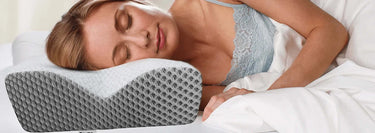Why Incline Geometry Controls Stability
Leg elevation is not only about “getting your feet up.” The geometry of the incline decides how your body loads the wedge, how your hips and lower back settle, and whether the position feels calm and repeatable or awkward and unstable. A few degrees in the wrong direction can shift force into the joints instead of routing it through a broad, supportive surface.
This page explains how ergonomic incline angles work in practical terms. You will see how angle, height, and body size interact, why certain ramps feel naturally stable, and how structured support helps your body downshift after long periods of sitting or standing.
Table of Contents
- 1. What Is an Ergonomic Incline Angle?
- 2. How Incline Angle Shapes Alignment
- 3. Everyday Angle Ranges For Leg Elevation
- 4. Angle, Height, and Body Size Working Together
- 5. Upward Incline vs Ergonomic Incline
- 6. Practical Angle And Session Chart
- 7. How Zen Bloks Wedges Encode Ergonomic Angles
- 8. Routine Patterns That Use Angle Intentionally
- 9. Glossary: Angle And Alignment Terms
- 10. Compliance Notice And Lifestyle Focus
1. What Is an Ergonomic Incline Angle?
You can prop your legs on pillows, a sofa arm, or a chair, but those shapes collapse and change every time you move. An ergonomic incline angle is different. It is:
- Defined within a realistic angle range instead of guessed on the fly.
- Designed to spread load through the whole wedge, not into sharp contact points.
- Stable enough that you can repeat the same position night after night.
- Shaped to follow natural curves so the body settles instead of fighting the surface.
In other words, ergonomic incline design focuses on mechanics and behavior. The goal is not maximum height. The goal is a position where the lower body can relax, the spine feels supported, and everyday tension has space to ease rather than accumulate.

(Above) This comparison shows how incline angle changes the entire elevation profile of a wedge. Panel A illustrates a 30 degree incline with a longer, more gradual ramp that supports a smooth transition along the leg. Panel B shows a 45 degree incline that lifts the legs more aggressively and relies on a shorter, steeper rise. Angle alone shifts how force travels through the wedge and how easy it is for the body to stay settled.
The Lower Ramp: Entry Angle & Leg Positioning

(Above) This diagram shows how the load path changes with different incline profiles. A shallower ramp creates a longer, lower angle path that spreads weight over more surface area. A steeper ramp shortens the load path and pushes more force into a compact region.
Zen Bloks treats incline geometry as part of a complete system that also includes:
- Body sizing guidance in Leg Elevation Height by Body Size.
- Timing and rhythm in How Long Should You Elevate Your Legs.
- Daily reset concepts in Leg Elevation Benefits for Daily Reset and Everyday Comfort.
2. How Incline Angle Shapes Alignment
When you rest your legs on a wedge, the angle between your legs and the surface decides how the load moves through the ankles, calves, knees, thighs, hips, and the lower back. Even a small change in incline can alter:
- Where you feel tightness or ease.
- How long the position feels comfortable.
- Whether your body feels grounded or slightly on edge.
To make this easier to read, we will look at three main zones: the ankle and calf region, the knees, and the hip and lower back.
2.1 Ankle and Calf Zone
At the base of the wedge the ankles and calves are usually the first contact point. If the ramp is too steep, the back of the calf can feel compressed and the heels may dig into the surface. If the ramp is too shallow, the lower legs feel almost flat and the elevation signal weakens.
A well tuned ergonomic incline:
- Supports the lower legs without sharp transitions under the Achilles area.
- Provides enough lift that leg heaviness starts to ease.
- Reduces the urge to shift around chasing a comfortable spot.
2.2 Knee Position and Flex Angle
The knee angle is one of the most sensitive parts of leg elevation. When the incline is balanced, the knees rest in a gentle flex with broad support behind them. When the angle is off, the knees feel either locked or overly compressed.
Key behaviors to watch:
- If the wedge is too high for your height, the knees bend sharply and stiffness can build over time.
- If the wedge is too low, the experience feels subtle and less like a meaningful reset.
- Balanced angles let the knees “float” while the surrounding muscles soften.
2.3 Hip Angle and Lower-Back Behavior

The hip angle and lower back posture decide whether leg elevation feels like a natural resting shape or an awkward pose. The incline angle shifts how the pelvis rests on the mattress or sofa.

- Too much angle can tip the pelvis enough to make the lower back feel sharply arched.
- Too little angle barely changes the line of the body and may not feel like a real alignment change.
- A balanced incline lets the hips settle while the lower back rests into a calm, natural curve.
Zen Bloks geometry is tuned so that when your legs rest in the intended support zone, the hip and lower back line feel supported rather than forced. This is the main difference between a shaped ergonomic wedge and stacks of pillows that collapse and shift every time you move.
3. Everyday Angle Ranges For Leg Elevation
Every body is unique, but real world use clusters around a few angle ranges that consistently feel stable for daily routines. Instead of chasing a single “perfect” degree, it is more useful to think in terms of bands matched to how you plan to use the wedge.
3.1 Reset Range: Short Breaks After Sitting or Standing
For 10 to 20 minute resets after desk work, long drives, or time on your feet, many people settle into the 20° to 30° incline band.
In this range:
- The legs feel clearly elevated, not slightly propped up.
- The calves rest in the wedge rather than hanging off an edge.
- The body gets a strong “position change” signal without feeling forced.
This band maps well to the timing guidance in How Long Should You Elevate Your Legs, where short, focused resets outperform very long holds that create new tension patterns.
3.2 Evening Range: Wind Down and Screen Time
For 20 to 45 minute evening sessions while reading or watching a show, a slightly softer incline around the 18° to 28° band often feels more sustainable.
- The legs sit clearly above the hips without feeling extreme.
- The lower back tends to feel calmer during longer holds.
- The position pairs well with an ergonomic head pillow so the whole spine feels coordinated.
Many Zen Bloks users treat this band as their “default evening angle” for winding down, connected directly to the benefits in Leg Elevation Benefits for Daily Reset and Everyday Comfort.
3.3 Extended Range: Longer Rest Blocks
When elevation is part of a longer evening routine, such as 45 to 90 minutes with small adjustments, a gentle incline in the 15° to 24° band usually works best.
In this range:
- More of the leg surface contacts the wedge, which evenly distributes pressure.
- The knees stay flexed but not sharply bent, so long holds feel easier.
- The pelvis stays quieter, which helps people who are sensitive to lower-back tension.
This band fits evenings where leg elevation is part of a broader rest plan that might also include a supportive head pillow, a breathable mattress, and light control to encourage a full-body calm state.
4. Angle, Height, and Body Size Working Together
Angle never exists on its own. The same wedge height creates different inclines for different people. That is why Zen Bloks separates height selection and angle behavior into two linked topics.
Height guidance lives in Leg Elevation Height by Body Size. This page focuses on how those heights feel once your legs are actually on the wedge.
4.1 Height Bands and Typical Angle Feel
The table below outlines common body size bands and how a medium or large wedge height often feels in angle terms. Treat it as a behavior reference, not a prescription.
| Height Band | Typical Wedge Height | Perceived Incline Behavior | Notes On Comfort And Tension |
|---|---|---|---|
| 5'0" to 5'4" | Medium wedge height | Feels closer to the upper end of each angle band. | Strong elevation effect. Great for short resets. For extended sessions some users prefer a slightly softer angle or minor foot position changes. |
| 5'5" to 5'8" | Medium or large, depending on preference | Sits near the center of each angle band. | Flexible zone. Users can decide based on how much lift they want during evening routines and how sensitive their knees and hips are to deeper angles. |
| 5'9" to 6'1" | Large wedge height | Brings legs into the intended ergonomic range. | Without adequate height this group often reports that elevation feels subtle. Proper height restores clear angle benefits without feeling extreme. |
| 6'2" and above | Large wedge height, with careful positioning | May still sit at the lower end of some angle bands. | Taller bodies benefit from precise placement so the knees and calves land in the designed contour region instead of past the crest of the wedge. |
This interaction between height and angle is why the Zen Bloks system keeps messaging consistent across product pages, guides, and the Leg Elevation Guide: How To Choose the Right Support.
4.2 Borderline Heights and Personal Preference
People who sit on the edge of two height bands often have more than one workable option. For example, someone who is 5'7" might be comfortable with either a medium or a large wedge depending on:
- How flexible their hips and knees feel.
- Whether they prefer intense short sessions or softer long ones.
- How much elevation they want relative to their torso position.
In these cases, reviewing real photos and setup diagrams on:
can help people visualize how their body will land on the wedge and which incline feels more natural.
5. Upward Incline vs Ergonomic Incline
It helps to separate two ideas that often get blended:
- Upward incline: any situation where the feet are higher than the hips for a short time.
- Ergonomic incline: a measured angle range designed for stable alignment, comfort, and repeatable routines.
An improvised upward incline might be a stack of pillows or a chair edge. It can work for a quick experiment, but the shape changes as soon as weight shifts. Angles are inconsistent and pressure points appear and disappear at random.
An ergonomic incline is anchored by:
- A known angle range that keeps knees, hips, and lower back in balanced positions.
- A structured surface that does not collapse into uneven lumps.
- A contour that guides the legs into the same posture each evening.
Zen Bloks wedges live in this ergonomic category. The incline is built into the geometry and foam density so each session feels familiar and controlled instead of improvised.
6. Practical Angle And Session Chart
The table below combines angle bands with session length and typical body behavior. It is written for lifestyle context and focuses on stability, comfort, and repeatable routines.
| Angle Band | Typical Session Length | Body Sensation Profile | Suggested Use Pattern |
|---|---|---|---|
| 15° to 20° | 30 to 90 minutes with light adjustments | Gentle float. Clear sense of elevation with minimal joint strain and easy long term stability. | Longer evening rest sessions paired with a supportive head pillow and a calm environment. |
| 20° to 28° | 15 to 45 minutes | Strong elevation signal. Legs feel noticeably lighter while hips and back stay supported when positioned well. | Evening wind down, reading, or screen time while paying attention to breathing and posture. |
| 28° to 32° | 10 to 20 minutes | Distinct lift with more calf and knee engagement. Best treated as a short, focused reset angle. | Quick mid day reset after travel or long standing periods, followed by a softer angle later. |
| Above 32° | 5 to 10 minutes only | Very pronounced incline. Joints and soft tissue may feel loaded if held too long. | Occasional variation rather than a nightly baseline. Most users prefer the more stable ranges above. |
When combined with the routines in Dynamic Leg Elevation Routines, this chart helps users build realistic, repeatable patterns instead of guessing at random angles every night.
7. How Zen Bloks Wedges Encode Ergonomic Angles
Zen Bloks wedges are not simple foam blocks cut on a diagonal. The visible incline is only the front end of a deeper design that also considers:
- Foam density that keeps the geometry stable through years of use instead of sagging into a new shape.
- Knee curve shape that cradles the back of the legs instead of digging into them.
- Surface width that lets the legs drift slightly without sliding off the side.
- Smooth heel-to-thigh transition so the body feels one continuous ramp, not a set of steps.
These elements work together to create a consistent incline experience. You do not have to rebuild a tower of pillows every night or guess whether the wedge is placed correctly.
For more structural detail, explore:
Angle by itself does not create comfort. Angle combined with contour, density, and width is what makes the wedge feel like an intentional part of a daily ergonomics setup.
8. Routine Patterns That Use Angle Intentionally
Structured routines turn ergonomic angles from theory into everyday habit. The examples below are lifestyle patterns for people who want leg elevation to feel natural rather than complicated.
Evening Reset Pattern
- Step 1: Elevate in the 20° to 28° band for 15 to 20 minutes after work while focusing on calm breathing.
- Step 2: Shift to a gentler 15° to 20° band for another 20 to 30 minutes during light reading or screen time.
- Step 3: Finish by sitting on the edge of the bed or sofa for a minute so the body can reorient before moving around.
This pattern delivers a strong reset followed by a softer hold, which keeps tension from rebuilding in a new area.
Desk Worker Pattern
- Short midday reset in the 20° to 30° band for 10 to 12 minutes.
- Evening routine in the 18° to 26° band, pairing a leg wedge with an ergonomic head pillow.
- Occasional weekend sessions in the 15° to 22° band for longer rest blocks.
This pattern supports people who spend long hours sitting and want to guide their body toward more balanced alignment with manageable steps.
Active Lifestyle Pattern
- Post activity reset at 22° to 28° for 10 to 20 minutes to calm lower body fatigue.
- Nightly elevation at 18° to 24° for 20 to 40 minutes while watching a show or listening to music.
- Optional extended rest once or twice a week in the 15° to 20° band for up to an hour with small micro adjustments.
Combining angle awareness with body feedback helps active people avoid overloading one area and supports more consistent alignment through the week.
For more ideas on building these patterns into real days and nights, users can connect this page with:
9. Glossary: Angle And Alignment Terms
- Ergonomic incline angle
- A controlled elevation angle range chosen for daily use, designed to support posture, reduce unnecessary strain, and feel sustainable over time.
- Neutral pelvis
- A hip position where the pelvis is not heavily tilted forward or backward so the lower back can stay calm and supported on the resting surface.
- Neutral spine
- The natural S shaped curve of the spine, where each segment feels supported rather than flattened or exaggerated by the elevation setup.
- Structured support
- A stable surface that maintains its shape, angle, and contour from session to session so the body can rely on a consistent experience.
- Angle band
- A practical incline range, such as 18° to 24°, used to describe how a position feels and how long it can be held comfortably.
- Lower body tension
- A mix of tightness, fatigue, and mild stiffness in the legs and hips that often builds after long sitting or standing sessions.
10. Compliance Notice And Lifestyle Focus
The information on this page focuses on ergonomic alignment, daily comfort, and lifestyle oriented leg elevation practices. It is not intended to address specific health conditions or replace guidance from a qualified professional.
Zen Bloks products are ergonomic comfort and support items, not healthcare devices, and are designed for everyday posture and relaxation routines.





